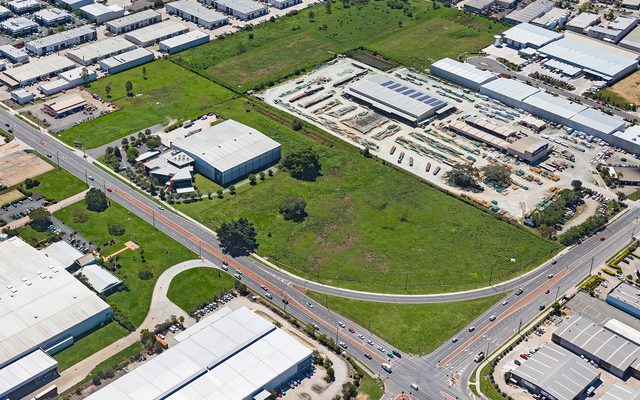This article is from the Australian Property Journal archive
A SHORTAGE of existing and speculatively built industrial stock across is putting upward pressure on land prices, and landlords can expect to see stronger rental growth in the coming years as a result.
According to Cushman & Wakefield, Melbourne has seen a strong run of leasing activity since 2019 that has continued into 2021.
Investment yields have remained firm and may fall further with the prospect of rental growth increasing investor appetite. Melbourne’s the northern market has seen yields in the sub-5,000 sqm segment tighten by 146 basis points over 12 months, and by 130 basis points for the 5,000 sqm-plus segment.
Yields have firmed by 47 basis points in the south east and by 68 basis points in the east, while they have eased by 87 basis points and tightened by 104 basis points throughout the west in the respective categories.
Land and building absorption have doubled the post-GFC average and “shows no sign of letting up”, according to Cushman & Wakefield national director, research, Tony Crabb.
Crabb recently told an Australian Property Institute and REIV conference that Melbourne’s industrial land supply will run out in five to 15 years. Some 6,562.5 hectares of vacant zoned land currently remains.
Vacancy in the form of existing and speculatively built product is at historic lows, below 2% and speculatively built product has largely been leased over the past six months and vacancy remains tight in most markets, particularly the south east.
In the north, walls and ceilings industry specialist, Intex Group International Pty Ltd has just acquired a $11,300,000 foothold in Vaughan Constructions’ Biodiversity Business Park in Melbourne’s northern suburb of Epping. The design and construct deal between Vaughan will see a new 7,591 sqm warehouse and office headquarters developed by the construction company.
Multinational corporation Intex is expanding its operations with the new headquarters in Epping that will be supporting its other warehouse locations and representation. CBRE’s Daniel Eramo negotiated the deal.
Industrial rolling annual sales of $2.9 billion was recorded in Melbourne in the year to March, according to Cushman & Wakefield measurements, including $1.35 billion in the December quarter alone with foreign and domestic institutions such as ARA Logos, GIC, GPT, Stockland, JP Morgan, Allianz, BlackRock and Charter Hall active.
This week ESR Australia and GIC bought 45 industrial properties from private equity firm Blackstone for $3.8 billion on a tight 4.5% yield — in Australia’s largest ever logistics portfolio transaction.
The acceleration of demand for warehousing facilities during the pandemic will likely see this year’s industrial supply volumes total 2.2 million sqm along Australia’s east coast – 80% of which is to be delivered in Melbourne and Sydney – and breeze past the long-term record set in 2020. Between now and 2025, an additional 2.3 million of floorspace will be taken up by the e-commerce sector.
Year on year face rental growth in Melbourne has risen in most precincts and most size ranges. Incentives have risen in some markets over the year, particularly the north, but have stabilised more recently. Outgoings remain unchanged.
“A shortage of existing and speculatively built stock is putting upward pressure on land prices and should translate into stronger face and effective rental growth in coming years,” Crabb said.
Net face rents grew by 6% in the west for assets below 8,000 sqm and by 3% for those above, and by 5% across the south east. They lifted modestly for assets above $5,000 sqm in the north and were steady in the east.
Yields across Sydney were largely unchanged over the past six months at 4.0% to 5.5%, although south Sydney narrowed to 4.05% to 5.0%.
Prime net face rents across Sydney were largely unchanged over the past six months, averaging $155 per sqm for the 2,000 sqm to 5,000 sqm range. Incentives were also generally steady at about 10%.
There was an 8% year-on-year increase for vacant land below 10,000 sqm. Despite the new supply and an uplift in transaction activity throughout 2020, prime net face rents across Brisbane were largely unchanged over the past six months
Transaction volumes hit record high in 2020
According to Cushman & Wakefield, 2020 was a record year for the Australian industrial market with transactions totalling over $6.3 billion. This compares to JLL’s measurement of $4.4 billion.
Some $45 billion of capital is looking to be deployed into Australian real estate in 2021, and this year’s transactions figure has just been given a mammoth boost by ESR and GIC’s record $3.8 billion acquisition of the Milestone Logistics portfolio from Blackstone.
Logos’ soon-to-be-completed $1.65 billion purchase of the Moorebank Logistics Park in south west Sydney from Qube will also add substantially.
NSW industrial transaction volume was relatively low over the March quarter, Cushman & Wakefield said, totalling $114 million. This compared to $289 million in the December quarter and $773 million in the September period.
Queensland saw over $1.1 billion of industrial property change hands in 2020. The December quarter saw $533 million of sales.



















